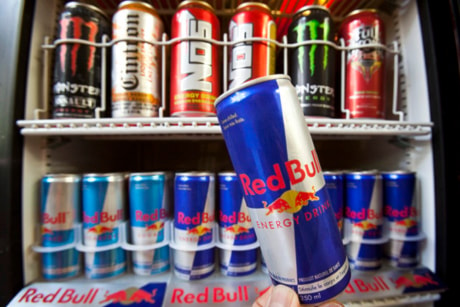TORONTO — How caffeinated are our kids? The Canadian Medical Association Journal thinks it’s a question we ought to be asking.
The journal’s senior editors have published an editorial voicing alarm over the increasing popularity among kids and teens of energy drinks, some of which contain as much caffeine as several cans of cola or cups of coffee.
“Caffeine-loaded energy drinks have now crossed the line from beverages to drugs delivered as tasty syrups,” the editors of the journal said in the editorial, released Monday.
They said Health Canada should require producers to use clearer labelling and should bar promotion targeting the child-and-teen market. They also suggest parents need to be informed about the caffeine contents of the drinks their kids are downing.
“We need to educate parents and kids that these things are addictive or are potentially addictive. They carry concerns with use,” Dr. Paul Hebert, editor-in-chief and one of the signatories to the editorial, said in an interview.
An industry body, Refreshments Canada, took exception to the editorial, suggesting the article contains a number of inaccuracies that the group attempted to set straight before publication, to no avail.
In a letter to the editor distributed by the group Monday, Refreshments Canada said the products are regulated by Health Canada as natural health products, not foods as the editorial suggests. Labels clearly indicate the drinks aren’t meant for children, pregnant women or nursing mothers and — contrary to another claim in the editorial — lay out how much caffeine from all sources are contained in the products.
“In Canada, by volume, mainstream energy drinks have approximately less caffeine than a cup of filter drip coffee (80 - 140 milligrams per energy drink versus 179 mg per 237 ml cup of coffee),” the letter stated.
“Nowhere in Canada are there energy drink products with caffeine approaching the levels you suggest in your article, although Canadians regularly consume some coffee products that come close.”
Health Canada backed up the industry group’s claim regarding how the products are regulated.
“Due to their medicinal ingredients (such as caffeine, taurine and vitamins), and the claims they make, energy drinks are regulated in Canada as natural health products (NHPs) under the Natural Health Products Regulations, not as foods as was stated in the article,” the department said in an emailed response to questions.
The drinks must list recommended conditions for use and warnings on their labels, the email added.
In an interview, Refreshments Canada communications director Alan Grant insisted the group’s members — beverage heavyweights like Pepsi-Cola, Coca-Cola and Red Bull — don’t target children in their advertising. “Our members adhere to responsible marketing practices,” he said.
But advertising isn’t the only way to bring one’s product to the attention of a target audience. Strategic sponsorships are effective ways of generating product buzz within desired demographic groups.
Two of the biggest stars of the Vancouver Olympics, downhill skier Lindsey Vonn and snowboarding phenom Shaun White, are both sponsored by Red Bull, one of the best known energy drinks on the burgeoning market. Commentators often noted during competitions that Red Bull had built White his own practice half-pipe. Vonn, who arrived in Vancouver nursing a shin injury, told a packed news conference she’d been looked after by Team Red Bull in Europe during the agonizing wait to see if she could compete.
Hebert said the idea for the editorial arose in June, when one of the journal’s editors was walking her 11-year-old to school. They passed a convenience store where a bunch of kids had congregated. Littered around the front were discarded energy drink cans.
The editorial noted that caffeine pills, which contain several times less caffeine than energy drinks, come with mandatory health warnings against use by children and cautions to limit use because excess caffeine can cause nervousness, irritability, sleeplessness and even rapid heart rate on occasion.
The editorial called for labelling that represents the total caffeine content of the drinks set out in ways the public can understand, such as how many cups of coffee an energy drink would equate to. Currently the labels talk about milligrams of caffeine, which demands consumers know recommended daily limits.
Grant said Refreshments Canada feels the labelling and regulation of these products is adequate as is. “It’s our belief that specific restrictions are unnecessary for this small segment of the market,” he said.
But others supported the thrust of the journal’s editorial.
“Parents and independent experts know that kids need to eat more fruits, vegetables and whole grains and less white flour, added sugar and trans fat-laden oils and sugary soft drinks to have fit, healthy bodies and minds,” said Bill Jeffery, national co-ordinator for the Centre for Science in the Public Interest.
“Governments have to do a better job of protecting kids from clever marketers who have no compunctions about flogging chemical buzzes and mildly addictive junk foods.”
And Toronto dietician Rosie Schwartz said parents need more help figuring out what is in products like energy drinks, help they could get from clearer labelling rules from Health Canada.“Kids with behavioural problems, with hyperactivity, kids who may have sleep problems and mood disorders and behave in a hyperactive way — how much of that is due to food and beverage choices?” she asked.
“Whether it be artificial dyes or whether it be due to caffeine, I don’t think parents are getting a lot of help from Health Canada.”
Health Canada suggests kids aged 10 to 12 shouldn’t consume more than 85 mg of caffeine a day, which is about a can or two of cola. With younger children, the recommended maximum is even lower: 45 mg for children aged four to six and 62.5 mg for children aged seven to nine.
The department doesn’t have a specific recommendation for kids 13 and older, saying they don’t have enough data to calculate one. They suggest a weight-based approach be used, with teens not consuming more than 2.5 mg of caffeine per kilogram of body weight per day.
